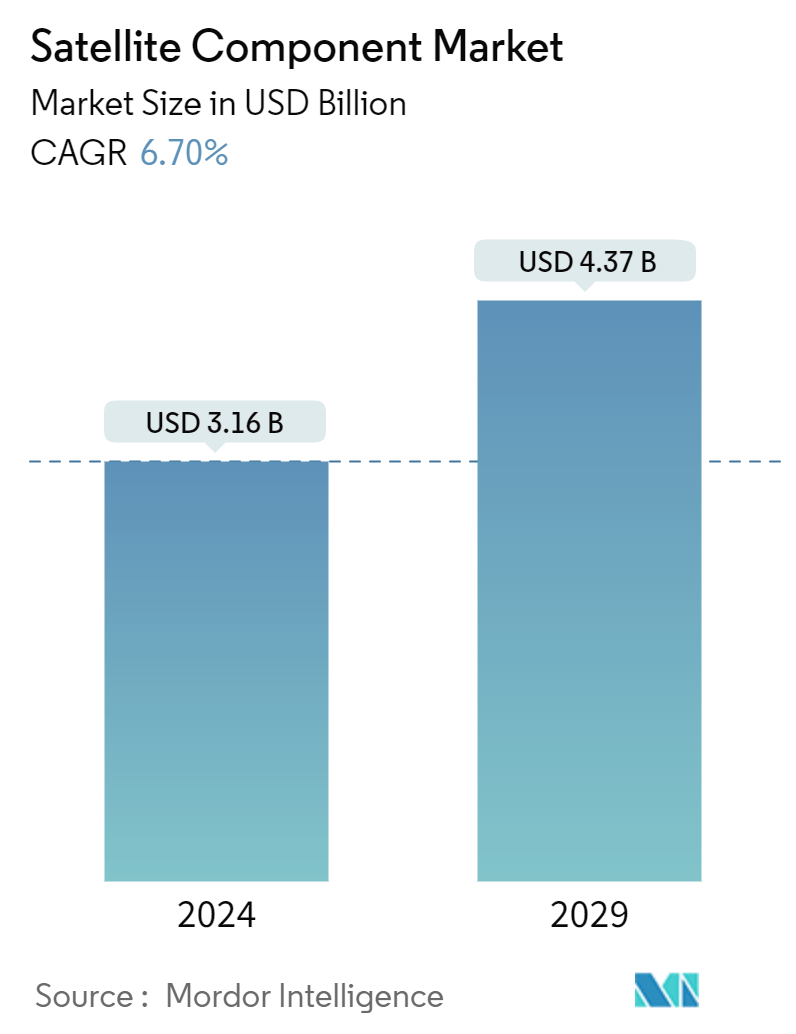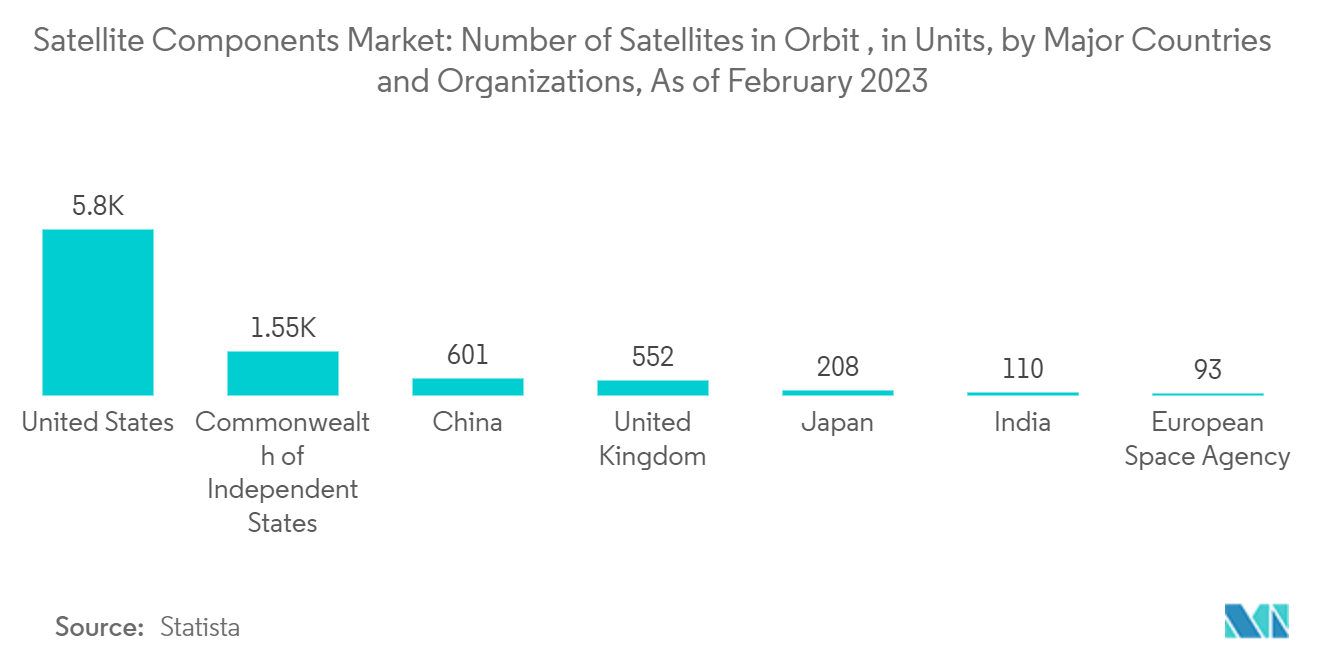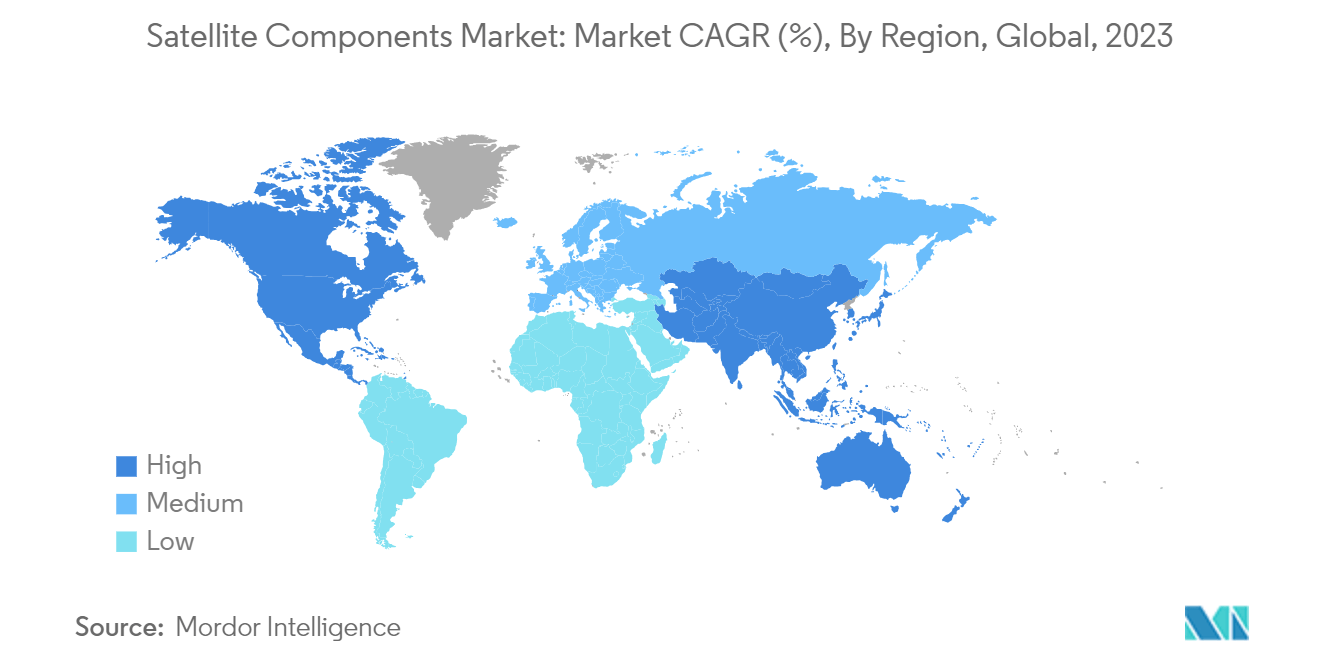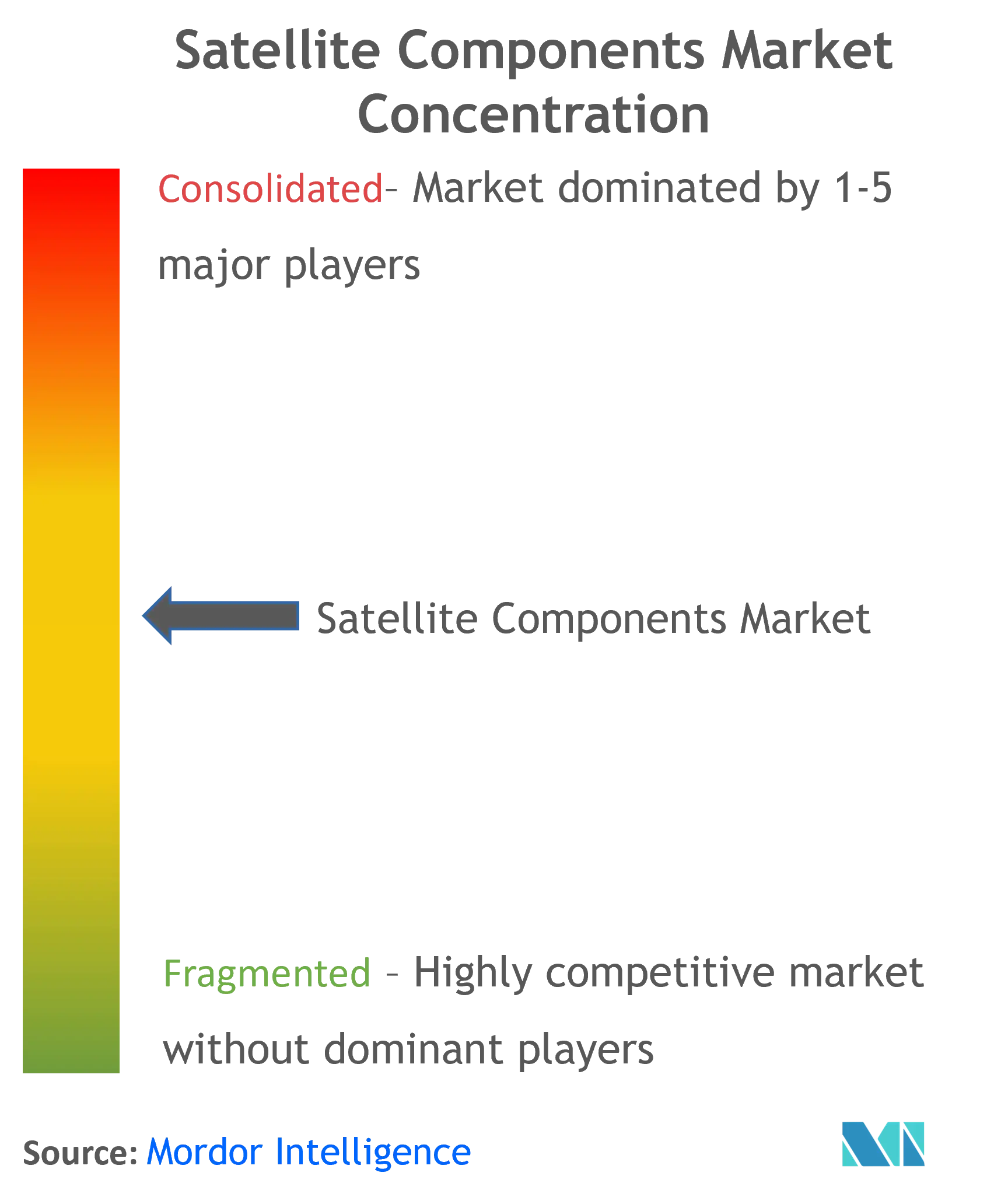Satellite Components Market Size

| Study Period | 2019 - 2029 |
| Market Size (2024) | USD 3.16 Billion |
| Market Size (2029) | USD 4.37 Billion |
| CAGR (2024 - 2029) | 6.70 % |
| Fastest Growing Market | Asia-Pacific |
| Largest Market | North America |
Major Players
*Disclaimer: Major Players sorted in no particular order |
Satellite Components Market Analysis
The Satellite Component Market size is estimated at USD 3.16 billion in 2024, and is expected to reach USD 4.37 billion by 2029, growing at a CAGR of 6.70% during the forecast period (2024-2029).
- The global satellite component market has faced unprecedented challenges due to the COVID-19 pandemic. The space sector witnessed challenges such as shortages of raw materials, delayed satellite launch programs, and supply chain disruptions due to strict government regulations. The market showcased a strong recovery after the pandemic. Increased expenditures on the space sector and rising small satellite launches drive the market growth post-COVID.
- The satellite components consist of the communications system, power systems, power systems, and others. The communication system includes antennas and transponders that receive and retransmit signals. The propulsion system consists of rockets that propel the satellite, and the power system includes solar panels that provide power. An increasing number of satellite launches and growing expenditure on the space sector drive the market growth. According to the United Nations Office for Outer Space Affairs (UNOOSA) index 2022, there were 8,261 individual satellites orbiting the Earth, with an increase of 11.84% compared to April 2021.
Satellite Components Market Trends
The Antenna Segment is Expected to Show Remarkable Growth During the Forecast Period
- The antenna segment is projected to show significant growth during the forecast period. The growth is due to increasing demand for advanced communication systems, rising number of satellite launches, and rising spending on the space sector. Satellite antennas are used to concentrate the satellite's transmitting power to the designated geographical region on Earth and avoid interference from undesired signals that will deteriorate the overall quality of the signal. Increasing satellite launches for various end-use applications such as communications, broadcasting, navigation, weather forecasting, and others drive the segment's growth.
- The United Nations Office for Outer Space Affairs (UNOOSA) stated that 155 orbital and suborbital launches took place in November 2022. Moreover, in June 2022, the Satellite Industry Association (SIA) unveiled the 25th annual State of the Satellite Industry Report (SSIR). The report indicated a remarkable deployment of 1,713 commercial satellites in 2021, reflecting a notable surge of over 40 percent compared to 2020. This escalating demand for satellites is set to trigger a corresponding need for satellite components, thereby propelling market growth in the projected period. As an illustration, a significant development occurred in July 2022 when MDA Ltd. entered into a contract with York Space Systems, a satellite manufacturer, to construct Ka-Band steerable antennas for satellites.

North America Held Highest Shares in the Market During the Forecast Period
- North America dominated the satellite components market and continued its domination during the forecast period. An increase in spending on space research and development and a rising number of satellite launches from the National Aeronautics and Space Administration (NASA) and SpaceX. In 2022, the US government spent approximately USD 62 billion on its space programs, making the country with the highest space expenditure in the world. There were 180 successful rocket launches worldwide in 2022, out of which 76 were launched by the United States.
- For instance, in September 2021, Terran Orbital, a satellite manufacturing company in the United States, announced that it would open the world's largest satellite manufacturing and component facility on Florida's Space Coast at a cost of USD 300 million. Furthermore, in December 2021, Redwire Corporation signed a three-year supplier agreement with Terran Orbital, a satellite manufacturer, to provide a range of advanced components and solutions used in satellite manufacturing and service offerings.

Satellite Component Industry Overview
The satellite component market is semi-consolidated, with a handful of players holding significant shares in the market. Some prominent market players are THALES, Viking Satcom, Lockheed Martin Corporation, Northrop Grumman Corporation, and Honeywell International Inc. With the growing competition, major original equipment manufacturers (OEMs) are focusing on designing and developing advanced satellite components and systems for space applications. Growing expenditure on research and development and design and development of next-generation satellite antennas, transponders, propulsion systems, and others will create better opportunities in the coming years.
For instance, in October 2021, the European Space Agency (ESA), French space agency CNES, and Thales Alenia Space, a satellite manufacturer, announced they would jointly develop a cooling system to maintain the temperature of big satellites in orbit. It will be the first mechanically pumped loop on large commercial telecommunications satellites.
Satellite Component Market Leaders
-
Lockheed Martin Corporation
-
Viking Satcom
-
Honeywell International Inc.
-
Northrop Grumman Corporation
-
THALES
*Disclaimer: Major Players sorted in no particular order

Satellite Component Market News
May 2024: Rocket Lab selected its suppliers to support the production of 18 satellites for the US military as part of the USD 515 million contract awarded by the US Space Development Agency (USSDA).
January 2024: The USSDA awarded L3Harris Technologies, Ltd. a contract with a potential value of USD 919 million to design and build 18 infrared space vehicles for the Tranche 2 (T2) Tracking Layer program, which will provide near-global missile warning and tracking coverage.
Satellite Component Market Report - Table of Contents
1. INTRODUCTION
- 1.1 Study Assumptions
- 1.2 Scope of the Study
2. RESEARCH METHODOLOGY
3. EXECUTIVE SUMMARY
4. MARKET DYNAMICS
- 4.1 Market Overview
- 4.2 Market Drivers
- 4.3 Market Restraints
-
4.4 Porter's Five Forces Analysis
- 4.4.1 Threat of New Entrants
- 4.4.2 Bargaining Power of Buyers/Consumers
- 4.4.3 Bargaining Power of Suppliers
- 4.4.4 Threat of Substitute Products
- 4.4.5 Intensity of Competitive Rivalry
5. MARKET SEGMENTATION
-
5.1 Component
- 5.1.1 Antennas
- 5.1.2 Power Systems
- 5.1.3 Propulsion Systems
- 5.1.4 Transponders
- 5.1.5 Other Components
-
5.2 Geography
- 5.2.1 North America
- 5.2.2 Europe
- 5.2.3 Asia-Pacific
- 5.2.4 Latin America
- 5.2.5 Middle East and Africa
6. COMPETITIVE LANDSCAPE
-
6.1 Company Profiles
- 6.1.1 Lockheed Martin Corporation
- 6.1.2 Viking Satcom
- 6.1.3 Sat- lite Technologies
- 6.1.4 Honeywell International Inc.
- 6.1.5 THALES
- 6.1.6 Northrop Grumman Corporation
- 6.1.7 IHI Corporation
- 6.1.8 BAE Systems plc
- 6.1.9 Challenger Communications
- 6.1.10 JONSA TECHNOLOGIES CO., LTD.
- 6.1.11 Accion Systems
- *List Not Exhaustive
7. MARKET OPPORTUNITIES AND FUTURE TRENDS
** Subject To AvailablitySatellite Components Industry Segmentation
The satellite components include command and data handling, guidance and stabilization, housing, antennas, thermal control systems, power systems, and transponders. The parts of satellites vary as per their functions, but the typical components include communication systems, power, and propulsion systems.
The satellite component market is segmented based on components and geography. By components, the market is segmented into antennas, transponders, power systems, propulsion systems, and others. Others include sensors and thermal control systems. The report also covers the market sizes and forecasts for the satellite component market in major countries across different regions. For each segment, the market size is provided in terms of value (USD).
| Component | Antennas |
| Power Systems | |
| Propulsion Systems | |
| Transponders | |
| Other Components | |
| Geography | North America |
| Europe | |
| Asia-Pacific | |
| Latin America | |
| Middle East and Africa |
Satellite Component Market Research Faqs
How big is the Satellite Component Market?
The Satellite Component Market size is expected to reach USD 3.16 billion in 2024 and grow at a CAGR of 6.70% to reach USD 4.37 billion by 2029.
What is the current Satellite Component Market size?
In 2024, the Satellite Component Market size is expected to reach USD 3.16 billion.
Who are the key players in Satellite Component Market?
Lockheed Martin Corporation, Viking Satcom, Honeywell International Inc., Northrop Grumman Corporation and THALES are the major companies operating in the Satellite Component Market.
Which is the fastest growing region in Satellite Component Market?
Asia-Pacific is estimated to grow at the highest CAGR over the forecast period (2024-2029).
Which region has the biggest share in Satellite Component Market?
In 2024, the North America accounts for the largest market share in Satellite Component Market.
What years does this Satellite Component Market cover, and what was the market size in 2023?
In 2023, the Satellite Component Market size was estimated at USD 2.95 billion. The report covers the Satellite Component Market historical market size for years: 2019, 2020, 2021, 2022 and 2023. The report also forecasts the Satellite Component Market size for years: 2024, 2025, 2026, 2027, 2028 and 2029.
Satellite Component Industry Report
Statistics for the 2024 Satellite Component market share, size and revenue growth rate, created by Mordor Intelligence™ Industry Reports. Satellite Component analysis includes a market forecast outlook to for 2024 to (2024to2029) and historical overview. Get a sample of this industry analysis as a free report PDF download.



